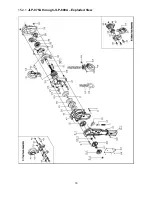
8
•
The vertical angle at the neck of the hook
reaches 10
°
(see Figure 3).
•
Chemical corrosion or cracks on the hook.
•
Excessive wear on the inside surface.
•
The throat opening has enlarged. (See
page 11 for the maximum allowable limits
for the throat opening.)
Figure 3
Do not attempt repair of a hook
by heat treating, bending or attaching anything
by welding. Such procedures will weaken and
may cause failure of the hook.
8.3
Other inspections
•
With the lever in the up position, while pulling
down on the chain or with a load connected,
check for a clicking sound when the handle is
rotated in a clockwise direction. If these sounds
are not present, or if
irregular
clicking noises
develop, do not use the hoist – have it
inspected and repaired by an authorized
service center.
•
With the lever in the up position, check free
play in handle rotation. Free play is measured
by the distance the handle travels before
resistance or gearing is felt. If free play has
reached 3/4 of a turn, brake discs are worn and
should be replaced by a JET authorized
service center.
•
The brake mechanism must be kept clean and
free from dirt, water, and oil. Never allow oil to
penetrate the braking mechanism. The brake
should not slip while using the hoist.
•
If the lever hoist has not been used for an
extended period of time, check for proper
operation before putting into service.
•
Always keep your hoist clean and store in a
clean, dry location.
9.0
Operation
The JLP Lever Hoist may be used either in vertical
position as a hoist; or in angled or horizontal
position as a puller. Below is the general procedure
for operating the hoist:
•
Set the top hook securely.
•
Correctly center the load on the bottom hook
(Figure 4). Incorrect loading is dangerous to
the operator, the lever hoist, and the load.
•
Never load the hook in front of the safety latch
(A, Figure 5).
•
Never load the hook tip (B, Figure 5).
•
Never load the hook off the centerline (C,
Figure 5).
•
Never load the hook sideways (D, Figure 5).
Figure 4
Figure 5

























